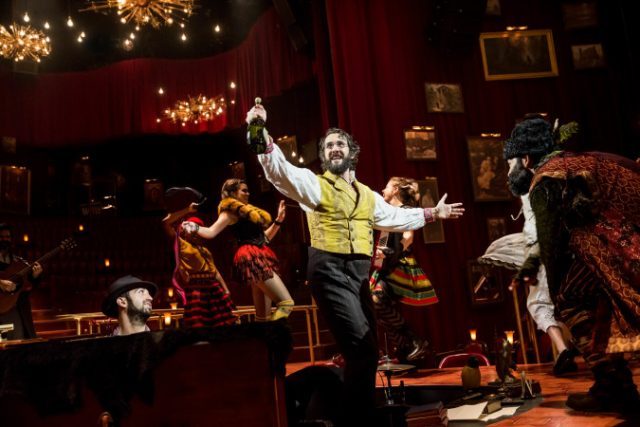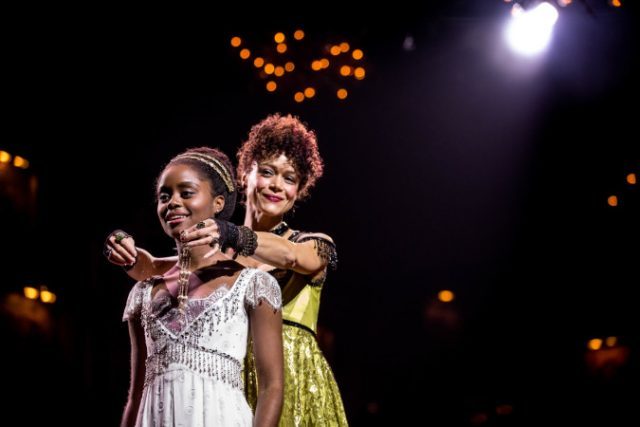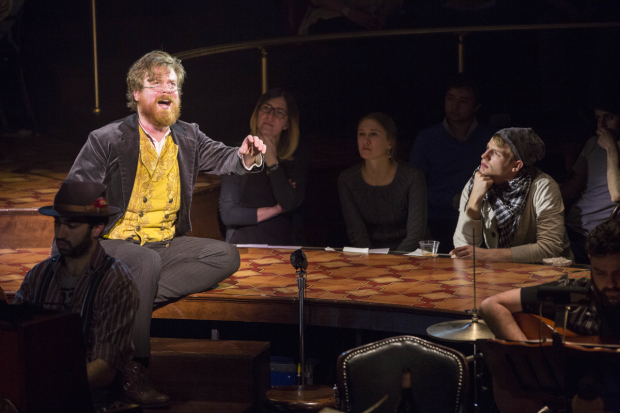
Josh Groban makes his Broadway debut as a cuckolded Russian aristocrat in NATASHA, PIERRE & THE GREAT COMET OF 1812 (photo by Chad Batka)
Imperial Theatre
249 West 45th St. between Broadway & Eighth Ave.
Tuesday – Sunday through September 3, $59-$189
greatcometbroadway.com
Hamilton, watch out; there’s a new historical musical in town, dueling it out for the designation of best show on Broadway. In his epic 1869 novel War and Peace, Leo Tolstoy wrote of his protagonist, Count Pierre Bezukhov, “At the entrance to the Arbat Square an immense expanse of dark starry sky presented itself to his eyes. Almost in the center of it, above the Prechistenka Boulevard, surrounded and sprinkled on all sides by stars but distinguished from them all by its nearness to the earth, its white light, and its long uplifted tail, shone the enormous and brilliant comet of 1812 — the comet which was said to portend all kinds of woes and the end of the world.” And there are all kinds of woes indeed in Natasha, Pierre & the Great Comet of 1812, Dave Malloy’s smashing electro-pop opera adapted from a 70-page section of Tolstoy’s classic tale, which has been magnificently transported to Broadway’s reconfigured Imperial Theatre. The little show that could began life in 2012 at 87-seat Ars Nova, where it ran for 39 performances. The next year it moved to the 199-seat tented Kazino cabaret in the Meatpacking District, and now it’s on Broadway, appropriately enough at the 1,200-seat Imperial, which set designer Mimi Lien (John, An Octoroon) has turned into an immersive wonderland, with ramps snaking from the stage throughout the theater and the audience seated in conventional chairs in the balcony and tavern-like chairs on the stage as well as in slightly sunken pits. The large cast of more than 40 actors and musicians emerge from every nook and cranny, every corner, even occasionally taking a seat right next to you and clinking glasses for a toast. You will be served a potato pierogi early on, and later a percussive egg to shake during some merriment. You might even get a page of War and Peace dropped in your lap. During intermission, you can roam anywhere, getting up close and personal with hundreds of paintings (many of Napoleon) that line the walls.

Countess Hélène Bezukhova (Amber Gray) has some dastardly plans for Countess Natalya Ilyinichna Rostova in immersive Broadway musical (photo by Chad Batka)
Set during the Napoleonic Wars, Natasha is a delightfully soapy story of love and betrayal in 1812 Moscow. The fabulous prologue introduces the major characters: brave Prince Andrey Bolkonsky (Nicholas Belton), who is away at war; “bewildered and awkward” Pierre Bezukhov (Josh Groban), a drunken cuckold who has given up on life; “young” Countess Natalya Ilyinichna Rostova, Andrey’s beautiful fiancée, called Natasha (Denée Benton); “hot” Anatole Kuragin (Lucas Steele), an immoral ladies’ man; “slut” Countess Hélène Bezukhova (Amber Gray), Anatole’s devious sister, who is married to Pierre; “good” Sofia Alexandrovna Rostova, Natasha’s trusted cousin, who goes by Sonya (Brittain Ashford); “crazy” Old Prince Bolkonsky (Belton), Andrey’s doddering father; “plain” Princess Mary Bolkonskaya (Gelsey Bell), Andrey’s sister; “old school” Marya Dmitryevna Akhrosimova (Grace McLean), Natasha’s godmother; “fierce” Fedya Dolokhov (Nick Choksi), a good friend of Anatole’s; and “fun” Balaga (Paul Pinto), a carefree troika driver. Don’t worry if it all doesn’t soak in immediately; there is a family tree in the program, which the cast suggests you refer to when necessary. After the prologue, a chorus declares, “Oh Pierre! Our merry feasting crank / Our most dear, most kind, most smart and eccentric / A warm-hearted Russian of the old school / His purse is always empty / Cuz it’s open to all / Oh Pierre / Just one of a hundred sad old men / Living out their final days in Moscow.” The downtrodden Pierre readily admits, “I never thought that I’d end up like this / I used to be better.” Attending an opera, Natasha sees Anatole and is instantly smitten with him, so the swaggering Anatole swoops down on her, soon proclaiming his undying love. Scandal ensues as there’s a duel, a costume ball, and various deceptions, leading to a deeply intimate and emotional conclusion.
“We are speaking of most ordinary things,” Anatole says at one point, but there is nothing ordinary about Natasha, Pierre & the Great Comet of 1812. Director Rachel Chavkin (The Royale, Small Mouth Sounds), who has been with the show from the start, finds endlessly inventive ways to bring this epic to life, as characters weave in and among the audience, the ensemble is always on the move, and the pace never lags for even a second. As Bradley King’s lights go down after one number, anticipation builds as to where the next song will begin. Choreographer Sam Pinkleton (Machinal, Significant Other) makes full use of the space, further involving the audience in the cast’s movements. The gorgeous costumes, by Paloma Young (Peter and the Starcatcher), range from elegant and fashionable to sexy and steam-punk. The ensemble is uniformly outstanding, from the wandering accordion players to the opera dancers (Reed Luplau and Ani Taj) to the larger roles, many of which are performed by the original Ars Nova actors, including Steele, Gray, Ashford (her “Sonya Alone” solo is stunning), Bell, Choksi, and Pinto. In her Broadway debut, Benton is both alluring and delicate as the torn Natasha, but the biggest surprise was Scott Stangland, who was subbing for an ill Josh Groban the night I went.

Scott Stangland gives award-winning performance as Pierre in ART production of musical now on Broadway (photo © Gretjen Helene)
In an 1858 letter to the editor comparing the comets of 1811 and 1858, British admiral and astronomer William Henry Smyth wrote, “In re the magnificent comet [of 1858], I have been closely attending to its fine figure; and am asked on various sides, as I had the advantage of having closely watched both, which I thought the most splendid in appearance, this, or that of 1811? Now, to my memory, which is very distinct, the palm must be given to the latter. As a mere sight-object, the branched tail was of greater interest, the nucleus with its ‘head-veil’ was more distinct, and its circumpolarity was a fortunate incident for gazers.” I feel very fortunate to have experienced the splendidly fine figure of Stangland, who played Pierre in the pre-Broadway American Repertory Theater production at Harvard in December 2015/January 2016 and who is absolutely magnificent at the Imperial, embodying Pierre as if he were born for the part. With his stout frame and bushy facial hair, he commands the audience’s attention whether taking center stage or playing the accordion or the piano in a pit. I was floored by the original presentation at Ars Nova, in which show creator Malloy, who wrote the music, lyrics, and book and did the orchestrations, played Pierre with an innate charm, and now I’ve been blown away by Stangland, who gives a profound performance that will break your heart — and left me playfully thinking, “Josh and Lin-Manuel who?”